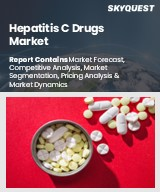
세계의 C형 간염 치료제 시장 규모는 2023년에 125억 달러로 평가되며, 예측 기간(2025-2032년)의 CAGR은 4.2%로 성장하며, 2024년 130억 2,000만 달러에서 2032년에는 180억 5,000만 달러로 성장할 것으로 예측됩니다.
세계 C형 간염 치료제 시장은 인지도 향상, 진단의 발전, 효과적인 치료 옵션에 힘입어 역동적으로 성장하고 있습니다. C형 간염의 유병률 증가는 특히 고령자 등 감염률이 높은 계층에서 항바이러스 요법에 대한 수요를 촉진하고 있습니다. 바이러스 박멸을 위한 정부 및 의료기관의 노력은 시장 확대에 더욱 기여하고 있습니다. 공중 보건 캠페인은 이 질병과 사용 가능한 치료법에 대해 고위험군에 대한 교육에 점점 더 중점을 두고 있습니다. 기술 혁신으로 인해 시장은 크게 변화했습니다. 95% 이상의 완치율을 달성하고 치료 기간을 단축하며 부작용을 최소화하는 직접 작용형 항바이러스제(DAA)의 등장이 대표적입니다. 또한 판게노유형 DAA와 정량적 제형과 같은 혁신은 치료 편의성과 복약 순응도를 향상시켜 더 많은 환자들에게 효과적인 치료를 제공할 수 있도록 돕고 있습니다.
Global Hepatitis C Drugs Market size was valued at USD 12.5 Billion in 2023 poised to grow from USD 13.02 in 2024 to USD 18.05 Billion by 2032, growing at a CAGR of 4.2% in the forecast period (2025-2032).
The global hepatitis C drugs market is experiencing dynamic growth, fueled by increased awareness, enhanced diagnostic advancements, and effective treatment options. The rising prevalence of hepatitis C infections is propelling demand for antiviral therapies, especially among demographics with higher infection rates, such as the elderly. Efforts from governments and healthcare organizations aimed at eradicating the virus further contribute to market expansion. Public health campaigns are increasingly focusing on educating high-risk populations about the disease and available treatments. Technological advancements have transformed the market with the emergence of direct-acting antivirals (DAAs) that achieve over 95% cure rates, reduce treatment durations, and minimize side effects. Innovations like pan-genotypic DAAs and fixed-dose combinations enhance treatment convenience and compliance, ensuring broader access to effective therapies.
Top-down and bottom-up approaches were used to estimate and validate the size of the Global Hepatitis C Drugs market and to estimate the size of various other dependent submarkets. The research methodology used to estimate the market size includes the following details: The key players in the market were identified through secondary research, and their market shares in the respective regions were determined through primary and secondary research. This entire procedure includes the study of the annual and financial reports of the top market players and extensive interviews for key insights from industry leaders such as CEOs, VPs, directors, and marketing executives. All percentage shares split, and breakdowns were determined using secondary sources and verified through Primary sources. All possible parameters that affect the markets covered in this research study have been accounted for, viewed in extensive detail, verified through primary research, and analyzed to get the final quantitative and qualitative data.
Global Hepatitis C Drugs Market Segments Analysis
The hepatitis C drugs market is segmented based on drug class, routes of administration, disease type and region. In terms of drug class, the market is segmented into direct acting antivirals (NS3/4A protease inhibitor, NS5A inhibitor, NS5B polymerase inhibitor), combination therapy, interferons, and others. Based on routes of administration, the market is segmented into oral, injectable, and others. Based on disease type, the market is bifurcated into chronic hepatitis C and acute hepatitis C. Based on region, the market is segmented into North America, Europe, Asia-Pacific, Central & South America and the Middle East & Africa.
Driver of the Global Hepatitis C Drugs Market
The growing prevalence of hepatitis C worldwide is significantly boosting the need for effective therapies, driven by factors such as intravenous drug use and unsafe medical procedures. As more individuals are diagnosed with this viral infection, the urgency for advanced treatment solutions intensifies. Additionally, increased awareness about the disease and its potential complications further propels the market for hepatitis C medications. Healthcare providers are focusing on improving screening and treatment options, leading to a greater demand for innovative drug formulations and therapies in the market, reflecting an overarching commitment to managing and ultimately eradicating this public health concern.
Restraints in the Global Hepatitis C Drugs Market
A major challenge facing the global hepatitis C drugs market is the high cost of direct-acting antiviral (DAA) medications, which remains a hurdle for widespread treatment in regions where healthcare budgets are constrained. In many countries, limited financial resources hinder healthcare systems from providing universal access to these essential drugs, despite some efforts to lower prices through competition and government negotiations. As a result, the economic burden associated with hepatitis C treatment continues to restrict access, leaving many patients without the necessary therapies and impeding progress toward eradicating the disease on a global scale.
Market Trends of the Global Hepatitis C Drugs Market
The global Hepatitis C drugs market is witnessing a marked transition toward affordable Direct-Acting Antivirals (DAAs) and generic formulations, driven by the expiration of patents and the implementation of voluntary licensing agreements. This trend is particularly significant in low- and middle-income countries, where access to cost-effective treatment options is crucial for controlling the virus. Enhanced affordability is pivotal, aligning with the World Health Organization's goals for Hepatitis C elimination, as it fosters increased treatment rates and expands the positive impact on public health. The increased availability of generics is reshaping the competitive landscape and facilitating broader access to lifesaving therapies.